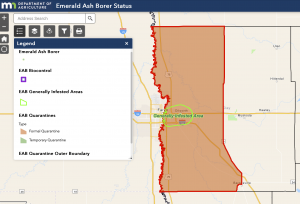In light of the recent flood, Fargo and Moorhead have been rapidly working on plans for flood diversions for the cities, but the diversions themselves won’t be completed for another 10-12 years. This may seem like a long time, but from the Army Corps of Engineers’ perspective, it is incredibly fast.
“The Corps has been absolutely amazed how a very difficult and complex project like this [is done],” said Mark Voxland, mayor of Moorhead. “We’ve been able to work hard to get cooperation and get this figured out.”
According to Voxland, the reason for the speed in figuring out the project is the attitude of cooperation and community that exists between the two cities. This is a rare situation for the Corps to deal with.
“The difficulty from this project, from the Corps’ standpoint is… there are two cities, two counties and two states. On top of that, they are dealing with many different watershed bodies in Minnesota and North Dakota,” Voxland said.
The diversions will be large drainage canals to divert water out of the Red River and around Moorhead and Fargo before depositing the water further downstream. Studies by the Army Corps of Engineers show that the canals would be a better solution than dikes because in the event that the river crests higher than the dike walls, the dikes would not contain the river. There is more room for changing flood levels with a diversion canal.
“The diversion offers you opportunities that a wall does not,” said Dennis Wallaker, mayor of Fargo.
Dikes would also significantly lower the property value of Fargo homes, which was a risk that Wallaker says the city wasn’t willing to take. According to Voxland, canals also make more sense because of the extremely flat geography of the area. With no high land to tie the dikes into, the flood wouldn’t be contained for the entire length of the floodplain.
“We’re so flat, we have nowhere to end the dike,” Voxland said.
The proposed diversions would be about 20 feet deep and half a mile wide, including the soil or dirt removed during excavation, which would be used to form a higher bank on either side. It would be designed to handle 20,000 cubic feet of water per second—the equivalent of 39 feet of water.
The proposed diversion plans are not without problems. One major problem is the funding. The diversions will cost approximately $1.2 billion. The federal government will pay 65 percent of the cost, and the local communities will supply the remaining 35 percent. However, this local share is not split evenly between Fargo and Moorhead. Fargo could end up paying as much as 90 percent of the local share, which some feel is unfair.
Another problem, according to Wallaker, is that by the Army Corps of Engineers’ estimates, communities downstream from Fargo and Moorhead could have more water to contend with as a result of the diversions. He said that there are no plans in place to deal with this problem yet.
“There are no perfect solutions,” Wallaker said.
While the Army Corps of Engineers suggests preparing the diversions to handle 39 feet of water, some also believe that a safer bet would be to build the diversions to take as much as 35,000 cubic feet per second of water, or the equivalent of 45.3 feet of water. According to Voxland, this would largely benefit Fargo, which is four feet lower than Moorhead.
“Four feet makes a lot of difference,” he said.
Wallaker agreed and said that much more property would be protected in Fargo if the diversions were built for higher water levels.
“Everybody agrees the 35,000 plan is a better plan,” he said.
All of these problems, however, will not necessarily be built into the final solution.
The proposals for the flood plan need to be authorized and appropriated by the congresses of both states before they can be put into place—processes which can take up to three years to complete. After that, the Moorhead diversion will require six to seven years to build, and the Fargo diversion will take eight years.
During that time, the cities will continue to fund studies by the Army Corps of Engineers to eliminate as many problems as possible. Wallaker feels that this is a lofty goal.
“It’s hard to satisfy everybody,” he said.
Voxland, however, disagrees. He feels that the work that has been accomplished so far was only possible because the communities of Fargo and Moorhead work together so well.
“We have a good history of that kind of cooperation,” he said. “That only comes because we trust each other…and that really is the basis of it.”







Be First to Comment